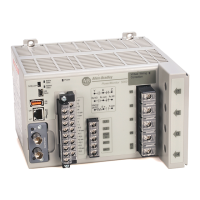Rockwell Automation Publication 1426-UM001J-EN-P - August 2019 31
Install the PowerMonitor 5000 Unit Chapter 2
Control Power
Connect the PowerMonitor 5000 unit to a source of 120/240V AC,
120/240V DC, or 24V DC (shown with dashed lines) control power through a
user-provided disconnecting means, such as a switch or circuit breaker close to
the power monitor. Provide overcurrent protection that is sized to help protect
the wiring, for example, a 5 A rated fuse. Overcurrent protection is included in
the 1400-PM-ACC accessory kit. The PowerMonitor 5000 unit is internally
protected. Apply control power only after all wiring connections are made to the
unit.
Figure 22 - Control Power
Connect Communication
This section describes how to connect communication networks.
USB Communication
The USB Device port can be used to create a temporary, point-to-point
connection between a personal computer and the PowerMonitor 5000 unit. This
connection is used for configuration, data monitoring, diagnostics, and
maintenance by using the built-in web pages of the unit. The USB Device port is
a standard USB Mini-B receptacle. Install drivers to enable USB communication.
To connect your personal computer to the PowerMonitor 5000 unit, use a
standard USB cable with a Type-A and Mini-B male plugs, Allen-Bradley® catalog
number 2711C-CBL-UU02 or equivalent.
**
**
L1
L2
GND
24V
com
Ground
24V DC
120/240V AC 50/60 Hz,
or 120/ 240V DC
TIP You can also display the PowerMonitor 5000 web interface by using a
PanelView™ Plus 6 terminal with a 2711P-RP9_ logic module with
extended features. USB communication drivers are already installed in the
logic module.
See Configure the Connection
on page 41 to continue the setup.

